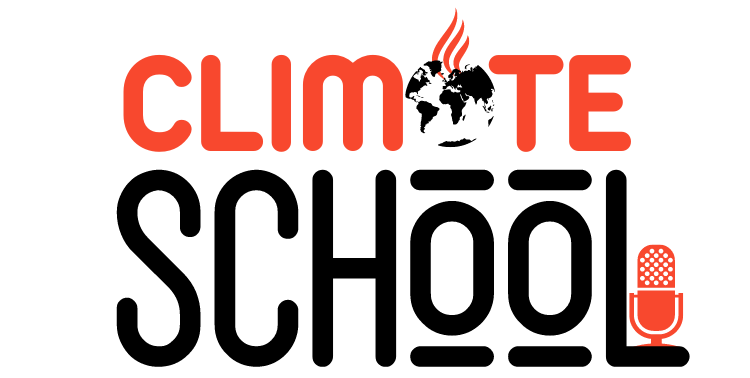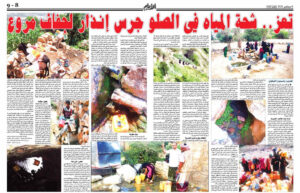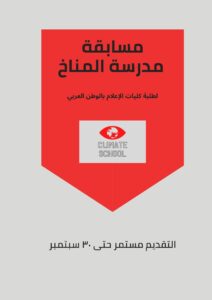Caspian Sea: NASA on the Splash website
Prepared by: Toby Malkintosh
Translated by: Jihad Al-Shebini
This report is based on GIJN, the Global Investigative Journalism Network, and you can view the original report from here
The Global Investigative Journalism Network has identified ten places journalists can turn to for free, cutting-edge support in obtaining satellite imagery for investigative reporting.
Satellite imagery is a powerful tool when it comes to exploration and analysis, and is used by journalists when covering topics such as conflicts, climate change, refugees, forest fires, illegal mining activities, oil spills, deforestation, slavery, and many other topics.
Smaller, cheaper satellites in low orbit are increasingly providing more detailed images taken in more numbers and in more places. With more than 175 satellites, Planet captures high-quality images of all of Earth’s land surface, 85 million square miles, every day. The high-quality images show features like roads, buildings, and the approximate color of crops and forests.
This support is provided not only by non-profit groups, but also by some of the largest commercial providers in the field, and experts can provide advice on obtaining and using images, dealing with technical issues, and more.
The GIJS Resources page also provides official sources for free satellite imagery, includes selected sources related to the use of the imagery, and longer lists of satellite imagery sources.
Sources for obtaining and using satellite images
Satellite images are a powerful tool when it comes to exploration and analysis, as well as providing live images and giving investigative journalists a real opportunity to make more use of these images captured from space, even if they use them to cover conflicts, climate change, refugees, forest fires, illegal mining activities. Legal issues, oil spills, deforestation, slavery and many other topics.
As one expert describes it, images: “independent of the thinking process used.”
Among other advantages, images are excellent for showing change over time on topics such as receding beaches, growing islands, or lost vegetation, and viewing the images can complement other research and provide supporting evidence.
GIJN's resources include ten go-to sources that offer professional support and free images, including high-quality images.
The list includes many non-profit organizations, but GIJN found that some of the largest commercial service providers are willing to assist journalists and provide them with images (see below).
Given the technical issues involved, reporters are advised to seek expert assistance.
“I would rather have journalists spend their time and effort doing the story and writing a great piece of work than sitting at a computer wondering what a Sentinel-2 image can do that a Landsat-8 image can’t,” says one expert in the field, who works for a group that helps journalists.
He and others whose work regularly focuses on satellite imagery believe that journalists can get much more out of satellite imagery.
See an article by Anne Hale McGleris, founder and executive director of Radiant Earth, a Washington, D.C.-based non-profit that applies satellite imagery to international development problems, for a good introduction to the basics of the topic.
Draw inspiration
Screenshot: Planet.com
Satellite imagery should become increasingly important to investigative journalism as the quality of the raw material improves. Smaller, cheaper, low-orbit satellites increasingly provide more detailed images, taken in more numbers and in more places. With more than 175 satellites, the US company Planet captures high-resolution images of all 85 million square miles of land on Earth every day. The highest resolution images show features such as roads and buildings and the approximate color of crops and forests. Resolution, now measured in tens of centimeters, shows even more, expanding the possibilities.
For inspiration, we offer several places where you can check out the latest stories based on satellite images.
Planet has a news section, Earth Rise Media provides a newsletter and case studies, and SkyTruth chronicles its projects.
One of the recent reports that caught our attention was by Estacio Valoi, a journalist with Oxpeckers for Investigative Environmental Journalism, and it dealt with the disputed lands in “Masingire”, a rural area located on the border between South Africa’s world-famous Kruger National Park and Mozambique. . See this explanation, which explains how satellite and drone images have been used.
Speaking at the GIJN conference in South Africa in 2017, Joel Konopo, a journalist with the INK Centre for Investigative Journalism in Botswana, explained the significance of a satellite image that was purchased and used to prove construction work was underway at the presidential building: “Using satellite imagery, we found a number of vehicles and military activity inside the building, despite the government’s continued denials.”
It is also worth noting the regular use of satellite imagery in investigations by UK-based non-profit Bellingcat. In 2018, Bellingcat used satellite imagery in an in-depth report entitled: “Disgraceful Negligence: Oil Pollution in Eastern Syria After the Conflict.” In another story, Bellingcat demonstrated that Iran was working to expand and lengthen an aircraft runway at a strategic airport.
Organizations that work with journalists
Screenshot: Earthrise.media
EarthRise Media: EarthRise Media helps journalists obtain, license, analyze and produce satellite imagery. Services provided by EarthRise include a newsletter featuring stories that would improve if they were supplemented with original satellite imagery. In addition to providing another service, which is analyzing and designing satellite images upon request. Since it is difficult for the lay reader/non-specialist to understand raw images, EarthRise uses filters to make the images easier to understand, while providing preliminary analysis and measurements of the images. How much water disappeared? How many buildings are there on an island in the South China Sea? Finally, EarthRise confirms that the images are licensed appropriately for use in the media. You can apply here.
Sky Truth: According to its founder, John Imus, this investigative group based in West Virginia is willing to discuss investigative projects all over the world. You can contact us via this email: john@skytruth.org.
Esri: Esri provides access to satellite imagery, analytics, and visual design tools that allow for the combination of images and other data to produce compelling, data-driven, journalistic stories using maps. Esri has a constantly updated database of world map images (as well as a cloud-free version, called Serenity), and also provides extensive resources for exploring and analyzing historical and current data from Landsat satellites, and also selects, organizes and displays A collection of images from the Living Atlas of World Content. You can keep track of photo updates with the help of this infographic. Esri also provides a variety of image manipulation tools, including ArcGIS Earth, a free 3D image viewing tool; Designed for those with less GIS knowledge, Story Maps offers a variety of map views with multimedia and narrative text.
Esri maintains strong partnerships with leading satellite image companies, and frequently publishes updated imagery related to important current events, such as the Olympics or disasters, on its ArcGIS Online mapping and analysis platform.
Thanks to a generous agreement with Esri, member organizations of the Global Investigative Journalism Network can apply for free licenses for the ArcGIS software used to process images and prepare maps. For more information, you can contact the Global Investigative Journalism Network here.
Maxar News Bureau: Since March 2017, Maxar Technologies, a provider of “advanced space technology solutions” for government and commercial markets, has run a “News Bureau initiative that leverages the power of high-quality satellite imagery and analysis for societal good and international transparency.” While Digital Globe, a unit of Maxar, captures some of the highest quality images available, the news office is set to partner with trusted media organizations on projects, offering its expertise and free images. Turner can be contacted. Brinton, email turner.brinton@maxar.com for inquiries.
Macroscope Media: Provides free support to journalists when it comes to stories containing satellite images, and a contribution from Jeff Stein, founder and CEO, allows discussion of satellite-related media projects. (No website), but you can check out his live presentation at the network conference in 2017, and contact him at this email: Jeff.Stein@macroscope.com.
Planet: It has a database called “Planet Stories”, which allows anyone to browse, compare and share images. It contains two tools: Compare and Timelapse. While Compare allows people to choose two images and place them in a slider for the purpose of comparison, Timelapse allows them to choose multiple images and create an animated model of a change. . Unusually, Planet collects daily images of land areas around the entire world. In addition, Planet is scheduled to share images and exchange experiences with accredited news organizations, and can be contacted through this email: press@planet.com.
Descartes Laboratories: A commercial service provider that collects data on a daily basis from those who provide images in a commercial and public way, which can also help journalists. For his part, Sean Patrick, who is the contact person for Descartes Laboratories, explains: “We are often contacted to produce images for media outlets, and we are pleased to provide assistance as long as we can, and we do not ask for anything in return, we only ask for help.” Attributed to us.” Patrick can be reached via this email: mailto:shawn@descarteslabs.com.
EOS: EOS Land Viewer offers free access to up to 10 images, and offers additional images and analysis at a discounted price for journalists. EOS is also developing a service tentatively called EOS Media that will provide free images and analysis of major natural disasters. Contact them at mailto:artem.seredyuk@eosda.com
Radiant Earth: A non-profit group that helps the global development community explore, research and analyze archives of aerial, drone and satellite imagery. Radiant Earth, among others, works with Code of Africa and can apply for assistance. From here, or from here.
Resource Watch: A nonprofit, still in beta, that offers hundreds of datasets on the state of the planet’s resources and citizens, and is supported by the World Resources Institute and other organizations. Resource Watch’s data is free, and users can download it. Contact them at Rose.Gilroy@wri.org.
Selected sources for free satellite images
Image from NASA on InSplash
There are many sources from which to obtain satellite images, and below are some of the easiest to use free options, followed by a list of “collections” containing more potential sources.
Earth Explorer: It is affiliated with the US Geological Service, and provides mainly American images and provides access to data from the Landsat satellites, in addition to NASA’s ground data services and products, while GloVis, affiliated with the US Geological Service, provides data Remote sensing: The USGS archive contains a complete and carefully preserved set of data received from NASA’s Landsat satellites.
Sentinel Hub Playground: An easy-to-use location for Landsat/Sentinel2 images. Free services on this commercial site include features of using different colors and up-to-date images, and the Earth Observation Browser facilitates time-lapse removal reviews.
Spectator: This free app simplifies image retrieval with semantic searches, for example: “cloud-free photos of New York from last month.” See YouTube video. Get a (free) account to create your own channel, in order to manage your areas of interest and which satellites you want to use.
Copernicus: It is the European Space Agency’s website for images taken by the six Copernicus Sentinel satellites, and it provides better quality than Landsat. You can check out the explanations on the GISGeography website, which explains how to download free images.
Google Earth Engine: It is a huge catalog containing satellite images and geographic databases, and has analytical capabilities on a planetary scale. Although the use of “Earth Engine” is free for research, educational purposes, and other non-profit uses, applications are still necessary. “Google Earth” is an enjoyable travel through a virtual world.
Google Maps: It provides detailed images and maps, and “Google Street View” provides images at ground level, and historical images are available for some places.
Bing: It has Microsoft maps and street shapes, and Bellingcat, an organization specializing in online investigations, points out that: “Bing offers newer and better quality images than Google, for example in Iraq.”
Wikimapia: a collaborative map making project; It is privately owned and its content is open source. It aims to identify all geographical elements around the world and provide a useful description of them, and it has no relation to Wikipedia. The site offers an interactive online map - based on the Google Maps API - consisting of user-supplied information and layered on top of Google Maps satellite images and other sources, and is available in many languages.
Terra Server: It is a huge image library that can be searched, but its non-private content is limited. However, some journalists consider a US$299 annual subscription a good investment.
NASA Earth Data: “WorldView” provides visual designs for near real-time images from “NASA”, offers a wide range of aerial and satellite images, has broad search criteria, and has other tools for creating maps and visual designs, including “Ferms”, which It can be used in fire situations, and allows access to more than a dozen NASA data centers and related satellite products, while NASA's Earth Observatory contains more than 50 data sets related to the atmosphere, land, Ocean, energy, environment, and more.
GeoVisual Search: A search engine that allows users to visually search for images of similar geographic features. It is a platform that emerged from Descartes Laboratories and relies on satellite imagery from Landsat, the National Agricultural Imagery Program, and PlanetScope. You can also find an explanation of how to use it here.
ESA Earth Online: This is a website that collects ESA Earth observation data on topics such as temperature, agriculture and ice cover.
Open Source Image Network: It collects open source images, and the network’s contributors work to make the images and related metadata available under a common license. The “Open Source Image Network” plays the role of a link between those who provide aerial images and satellite images. Humanitarian relief efforts, cloud hosting companies, and map nerds
balloon and drone capture, governments, NGOs, mapping companies, and anyone else who captures, hosts, and uses aerial images. Also, the “Open Source Aerial Map”, based on the “Open Source Image Network”, is an open service that allows searching and accessing these images.
EarthTime: This free service from the Enabling Technology, Education, Robotics, and Society Lab at Carnegie Mellon University in the USA “enables users to interact with designs related to changes in the Earth over time” and produce animations.
Resources related to using images
Storm in Yemen, NASA: That Splash
The Engine Room, an international NGO, provides extensive explanations of the use of satellite imagery in human resources investigations, covering where images are obtained and how they are used.
Getting Started with Satellite Investigations, including a list of resources and prices, by Lisa Gutermut, a program coordinator at the Tactical Technology Complex.
Understanding Satellite Data, an open source workflow: Accessing Data, is a four-part series by Robert Simon, of Planet Labs.
The American Association for the Advancement of Science has published a guide titled “Obtaining and Analyzing High-Quality Satellite Imagery” that includes “a few simple questions a researcher can ask to determine whether a satellite image might be useful.”
University Lists and Related Resources
Geo-Hack sources: A list of maps and satellite sources around the world, in multiple languages, created by Wikipedia.
Mashable: A summary of useful sites covering climate change, authored by Andrew Friedman.
A table of sources created by the Israeli geographer Harel Dan.
Gee. any. S. Geography: “Fifteen free satellite image data sources,” with comments on their strengths and weaknesses. Official sources in the United States of America, the European Union, Japan, India... and others. (See also general comments below for other proposals.) J. any. S. Geographie is a team of geographers who are passionate about all things related to understanding location. As well as other articles and lists, such as: “13 Open Source Remote Sensing Software Packages.”
Venture Radar: List of trading service providers.
Bellingcat Digital Debate Tools: A tip sheet featuring multiple sources, including satellite, from a group that uses open sources and social media to investigate various topics.
Knowing where to look, sources of geo-relevant images: Elliot Huggins of Bellingcat explains what he turns to for supporting evidence when there is a need to verify images or videos.
Journalists' Toolbox: A massive list of map-related resources provided by the American Society of Professional Journalists.
The Global Investigative Journalism Network welcomes suggestions to add to this resource. You can contact the network here, and you can also download this resource in PDF format from here.
This guide was completed by Toby McIntosh, Director of the Network's Resource Center, who worked at Bloomberg BNA, in Washington, for 39 years, and was also the former editor of FreedomInfo.org, from 2010 to 2017, where he wrote about free trade policy. Information about the world, and serves on the steering committee of FOIAnetK, an international network of freedom of information advocates.





